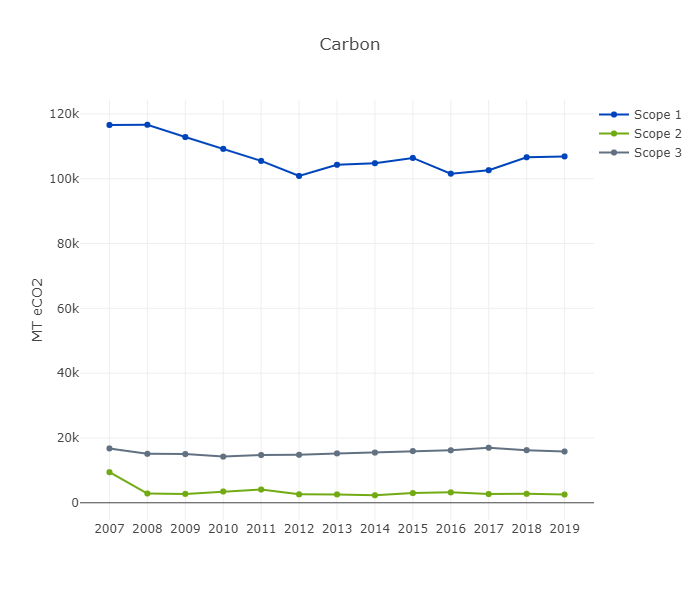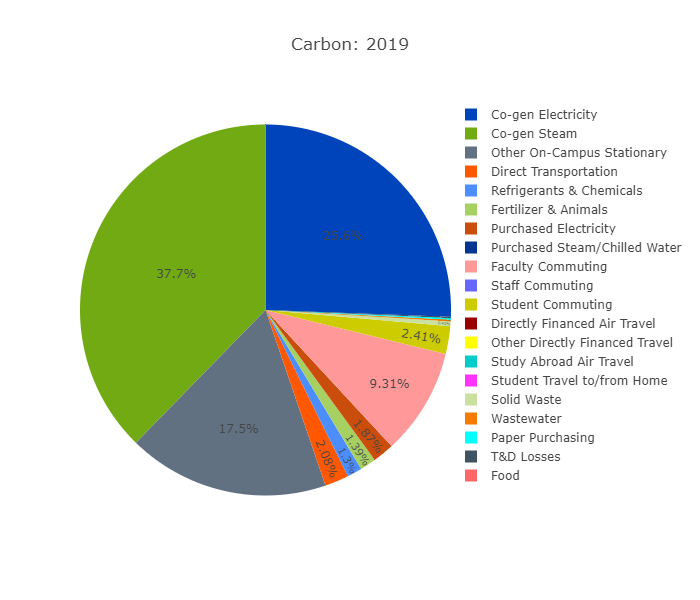The UConn Office of Sustainability performs an audit every year to determine our annual Greenhouse Gas Inventory. The data from this inventory is used in annual reporting for AASHE Stars Reporting, Sierra Club Cool Schools, and Second Nature President's Carbon Commitment.

Scope 1 (Direct Energy Usage): Stationary and Transport Fuels (including Co-Gen), Fertilizers, Animals, Refrigerants
Scope 2 (Indirect Energy Usage): Purchased Non-renewable Electricity, Heat, and other Utilities
Scope 3 (Other Indirect): Commuting, Purchasing, Waste and Wastewater

UConn's Climate Action Plan (CAP) has led to the implementation of several notable projects and initiatives. The CAP outlines plans to improve sustainability under the following categories: transportation, energy, and sustainable development. In Spring 2012, UConn added an adaptation section to work in conjunction with its mitigation strategies. This section is focused on UConn’s research, outreach and service roles, as we seek to provide resources for improving the climate resiliency of communities throughout the state and region. The mitigation strategies in UConn’s CAP serve to identify the emissions reduction benefits and cost effectiveness of potential action items. In 2016, UConn's Office of Environmental Policy created the 2020 Vision for Campus Sustainability and Climate Leadership, endorsed by President Susan Herbst, which provides suggestions for reaching the goals outlined in the CAP. Current emissions targets as included in the 2020 Vision call for a 20% decrease in emissions by 2020 and 30% by 2025. UConn’s overall progression includes:
- Class III Renewable Energy Credits (RECs) generated by UConn’s Co-Generation Facility, sold to finance energy efficiency projects across campus
- Relamping projects completed for more than $700,000 per year savings in energy costs and over 5,000 Tons eCO2 avoided
- Consistent relamping replacements with LEDs in both exterior and interior lighting, for a fully LED campus by 2020.
- 19 retro-commissioning projects completed for $2.2 million per year savings in energy costs and more than 12,000 Tons eCO2 avoided
- LEED Gold certification requirement for all new building and renovations over $5 million as of 2016
- Several variable-frequency drive (VFD) projects optimizing heating and cooling in buildings for around 1,000 Tons eCO2 avoided
- Long-term electricity purchasing agreement with ConEd for 100% of purchased electricity comprised of renewable energy (currently using wind power).
- Over 40% decrease in water consumption, despite 17% growth in user population from 2007-2017
- Agricultural/organic waste composting facility operating at maximum load of 800 tons per year
- Connecticut Institute for Resiliency and Climate Adaptation (CIRCA) established in January 2014
- 400 kW fuel cell and 7kW solar array, providing electricity, heating, and cooling to the Depot campus
- Department of Energy’s Workplace Charging Challenge pledge signed: 5 active EV charging stations and an expanding EV fleet
- Transportation light-duty fleet now includes 17 traditional hybrid vehicles, 12 plug-in hybrid vehicles, and 23 plug-in EVs.
UConn is still on track to meet its 20% interim reduction goal by 2020. This is being achieved primarily through on-going LED re-lamping projects in buildings, parking lots, and walkways, and with the replacement of old, inefficient steam pipes. These projects are expected to be completed between 2015 and 2020 and will yield an annual 13,265 ton reduction in carbon dioxide emissions. With all of these developments, UConn continues to strive toward carbon neutrality and a reduction of greenhouse gas emissions in the years to come. UConn’s Office of Sustainability uses the University of New Hampshire SIMAP Calculator to store and track greenhouse gas information.